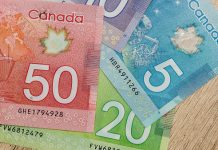- Closure of non-essential stores and stay-at-home orders weighed heavily on retail activity in April, with sales plunging by 5.7% m/m. The headline was slightly weaker than Statistics Canada’s preliminary forecast, which called for a pullback of 5.1%.
- Regionally, Manitoba and Ontario saw the sharpest decline in sales, which were down 8% and 13.4% respectively. On the flipside, New Brunswick, Newfoundland & Labrador and Alberta bucked the overall trend posting modest gains in April.
- Sales of motor vehicle & parts eased off for the first time in four months (-1.4%), with auto industry performance held back by the microchip shortage. Gasoline sales were also weaker in April, falling by 4.1% in nominal terms and 3.5% in volume terms.
- Core sales, which exclude the two above-mentioned categories, fell even more than the headline (-7.6%) with broad-based and double-digit declines across most categories deemed “non-essential”.
- Most retailers saw the steepest declines since the first wave of the pandemic. At clothing stores and stores selling sporting & hobby goods, books, and music, sales declined by 29% and 26%, respectively. Furniture (-15%) and electronic & appliance (-13.6%) stores also saw big declines.
- Food & beverage and miscellaneous retailers were the only categories with modest gains in April.
- Interestingly, online retailers didn’t seem to benefit much from limited in-person shopping this time around, with retail e-commerce sales edging lower by 0.4% on the month.
- Looking ahead, the agency’s flash estimate suggests that restrictions continued to exert a drag on retail activity in May, with sales declining by 3.2% in that month.
Key Implications
- As expected, third wave-related restrictions on non-essential and in-person shopping held back retail sales in April. In addition to restrictions, auto dealers were also impacted by the shortage of microchips, limiting their inventory and weighing on sales that month.
- While the microchip shortage may persist for some time, other headwinds will ease. With the vaccination campaign gathering speed and most provinces gradually lifting restrictions in June, consumer spending is on track to rebound strongly in the second half of the year.
- The recent announcement by the Canadian government that it will ease the quarantine requirement for fully vaccinated international travelers bodes well for the hardest hit travel and hospitality sector. Indeed, much of the strength in consumer spending in the second half of this year is expected to be concentrated in services, such as travel, recreation, and restaurant dining. Given its focus on goods spending, retail sales may lose some stream once the initial rebound in sales due to reopening and pent-up demand fizzles out, and consumers shift their attention to services.













